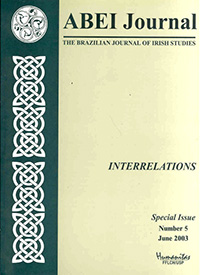Picture Bride: Fact or Image? – Immigration from Ireland and Japan
DOI:
https://doi.org/10.37389/abei.v5i1.182451Keywords:
Picture brides, immigration, Japan, Ireland, historyAbstract
In the early twentieth century, masses of immigrants from “underde- veloped” nations suffered depravation of honour, dignity and self-respect, de- spite their hopes and expectations, at the time of their entry into America. Ireland and Japan in those days were included among such nations, and female immi- grants were apt media targets for criticism or contempt. Feminist historians have pointed out that Irish women continued to suffer exclusion from the socio- economic discussion of massive emigration from Ireland to America for several decades. Likewise, Japanese women emigrants’ “lived” lives, after nearly three generations, still await thorough research and revelation. Only recently, their granddaughters have begun to explore their footsteps, and expose the true in- tentions of these women, their hopes, disillusionment and perseverance.“Picture Brides” was a term first employed by the Japanese government to evade the U.S. legal barrier against Japanese immigrants, after the Gentlemen’s Agreement in 1908, The term was applied to young women willing to marry on the basis of photographs provided through matchmakers. Soon it became a symbolic branding of female immigrants from nations which were poor, different in language, culture and values, and therefore, incomprehensible in the eyes of contemporary Americans. New York Times, in a 1922 article entitled “231 Picture Brides on Wedding Liner”, reported the arrival of female immigrants from Turkey, Rumania, Armenia and Greece, without any mention of Ireland. The picture panel at Ellis Island Immigration Museum in 1995, however, displays a photo of Irish women immigrants alongside the New York Times’ newspaper article as if perpetuating the discrimination in the media.To rescue their forerunners from disgrace and oblivion, attempts have been made by women researchers and artists to revive and retell the stories of those voiceless women. This paper will discuss this process of cultural salvage, using such films as Picture Bride in its attempt to show where Ireland and Japan met in the New World.
References
Bill, Teresa, “Field Work and Family Work: Picture Brides on Hawai’i’s Sugar Plantations, 1910-
”, in Picture Bride, HYPERLINK http://www.naatanet.org/picturebride/idx_main.html http:/
/www.naatanet.org/picturebride/idx_main.html, 10 October 2002.
Diner, Hasia R. Erin’s Daughters in America. Baltimore: The Johns Hopkins University Press, 1983.
Fujisaki, Yasuo (Ed.). Nipponjin-imin (Japanese Immigrants) 1.Hawaii and North America, 2. Brazil,
Central America, 4. Asia and Oceania). Tokyo: Nippon-Tosho-Centre, 1997.
Kelly, Kate; Choille, Tríona N. G. “Listening and learning: experiences in an emigrant advice agency”,
in Patrick O’Sullivan (Ed.). Irish Women and Irish Migration. London: Leicester University Press,
Mark, Diane Mei Lin, “Introduction” in Picture Bride, HYPERLINK http://www.naatanet.org/
picturebride/idx_main.html http://www.naatanet.org/picturebride/idx_main.html, 10 October 2002.
Murphy, Maureen, and Singer, Alan, and Miletta, Maureen McCann. The Great Irish Famine
Curriculum. New York: The University of the State of New York, 2001.
Ogawa, Dennis and Grant, Glen. “The Japanese in Hawai’i: 1885-1920” in Picture Bride,
HYPERLINK http://www.naatanet.org/picturebride/idx_main.html http://www.naatanet.org/
picturebride/idx_main.html, 10 October 2002.
Tanaka, Akira. “Training ‘Picture Brides’ in Japan and California at the Beginning of the Twentieth
Century: Forming Gender and Class for Japanese Emigrant Women” in Social Science. Kyoto:
Doshisha University Humanities Institute, 2002.
Tierney, Helen (Ed.). The Encyclopaedia of Women’s Studies, v. III. Westport/CT: Greenwood Press,
Yanagisawa, Ikumi “Nikkei-Americajin-isseijosei-no-rekishiteki-kousatu: ‘Ikirareta-rekishi’-wo-
chushinni (A Historical Study of the Japanese-American Issei Women: The Lived History of the
First Generation Women)” in Aichi Shukutoku University Studies of Multicultural Communications,
v. 1. Aichi: Aichi Shukutoku University, 1998.
____. (Forthcoming), “Shashin-hanayome-wa-naniga-mondai-dattanoka (Picture Bride: What was
at issue?)”.
Downloads
Published
Issue
Section
License
Copyright (c) 2003 Mitsuko Ohno

This work is licensed under a Creative Commons Attribution-NonCommercial 4.0 International License.


